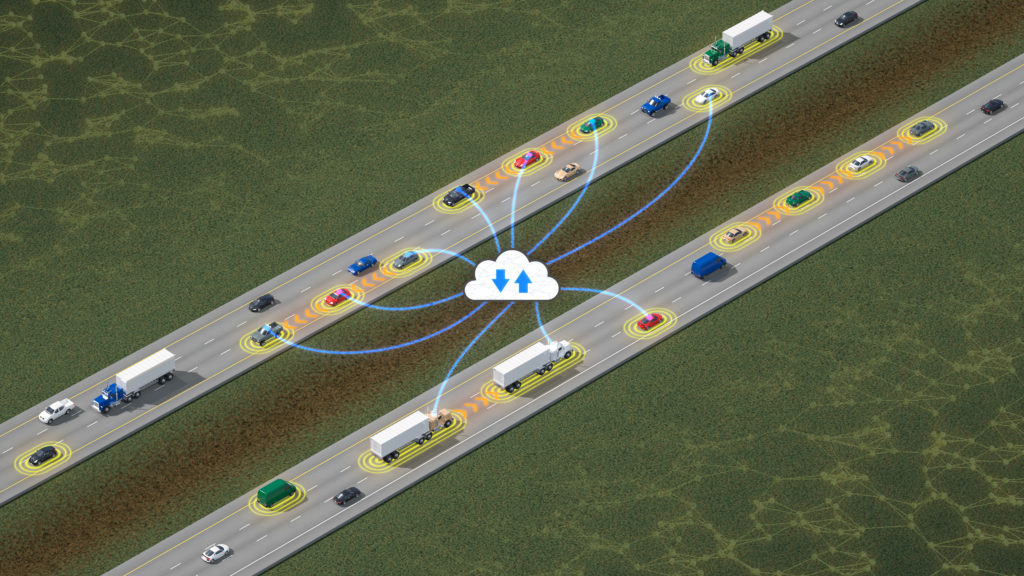How do transportation agencies plan for the unknown when it comes to connected and automated vehicles? How will CAVs impact current infrastructure when they become a quarter of traffic on roads? What about when they’re half of the traffic or more? What if there’s a marked difference between adoption among passenger cars and freight-carrying trucks? How does CAV adoption affect vehicle demands and other modes of transportation?
Many questions surround the topic of CAVs and their potential impact on our transportation systems. As agencies and planners grapple with how to approach projects that could have implications for many years to come, microsimulation software provides a way to model possible outcomes of CAV technology. For decades, microsimulation software has been used to evaluate complex traffic conditions not easily or accurately evaluated with more simplified tools. Now, we’re utilizing this sophisticated tool to evaluate CAVs. Predicting the operational performance and impacts of CAVs can guide planners in prioritizing changes, making the case for specific projects that are likely to provide the most effective solutions.
Budget-friendly solutions
Fueling the desire for agencies to invest in solutions surrounding CAVs are budget constraints. Agencies need to get the best ‘bang for their buck’ and CAVs are potentially one way they can do that, depending upon the situation and the challenges to be solved. By incorporating CAV microsimulation in their initial planning process, agencies can evaluate the impacts of CAVs along with other potential improvements.
In my work as a senior traffic engineer at HDR, I’ve focused on supporting agencies through transportation planning and traffic operations analysis. Over the past few years this focus has expanded to plan and evaluate technological applications surrounding CAVs. Much of this work has included using microsimulation software because it has the sophistication to provide meaningful answers for forecasting the possible impacts of disruptive technologies.
Complex modeling capabilities
We are using microsimulation software to model the complex interaction of CAVs with each other and with non-CAVs; and we can visually show how CAVs and non-CAVs can coexist to improve transportation systems. Developers of microsimulation software have begun adding more features to model these interactions, including car-following modifications that allow for reduced headway between CAVs, and reduced or eliminated stochastic car following. We have built further upon these, developing external scripts that allow for even more advanced modeling such as CAV platooning, lane interactions in freeway merge areas, and information exchange with roadside infrastructure such as signal controllers. Through that work, we can change parameters and characteristics of models as the capabilities of CAVs are refined and conditions change.
The results thus far are providing some exciting insights into what future highways might look like. The simulations we’ve evaluated for multiple states in rural and urban environments predict roadway capacity could increase as CAV adoption increases. With higher adoption rates, there are more opportunities to platoon CAVs, which can take advantage of knowing detailed information about more of the surrounding vehicles. Higher adoption rates may also allow for dedicated CAV facilities, similar to HOV/HOT lanes.
Beyond evaluating impacts from CAVs, microsimulation can evaluate the impacts of other new and future trends in transportation. This allows us to model the increased use of transportation network companies such as Uber and Lyft, Mobility as a Service, and changes to vehicle emissions as a result of electric vehicle adoption. Microsimulation route selection for shared mobility continues to evolve as well, with algorithms and scripts being developed to identify appropriate sharing of a trip based on origins, destinations, out-of-distance travel, user delay tolerance, and a number of other input variables. These scripts are set up to be adaptable as more defined algorithms for ridesharing become available.
Expanding potential
The functionality of microsimulation tools will continue to improve as CAVs and supporting technology evolve. Software developers are getting more heavily involved in major research projects in order to understand and test advanced technology solutions. This involvement is allowing them to adapt their tools to more accurately simulate advanced technology solutions. Developers are also leaning on the users of their products to share solutions that can be included in future software versions.
As we continue to push the boundaries of what microsimulation software can do, we keep expanding its potential. With new advancements every day, we’re better positioned to understand the impact of CAVs and how to optimize our current and future infrastructure to best take advantage of their benefits.
 Mike Forsberg serves as a senior traffic engineer at HDR and has worked with agencies to forecast the implications of CAV technology, including work with the Iowa Department of Transportation, including the I-80 Automated Corridor Study, and the Colorado Department of Transportation, where he helped develop a framework for incorporating CAVs into simulation models to forecast the possible impacts of this technology on traffic flow.
Mike Forsberg serves as a senior traffic engineer at HDR and has worked with agencies to forecast the implications of CAV technology, including work with the Iowa Department of Transportation, including the I-80 Automated Corridor Study, and the Colorado Department of Transportation, where he helped develop a framework for incorporating CAVs into simulation models to forecast the possible impacts of this technology on traffic flow.


